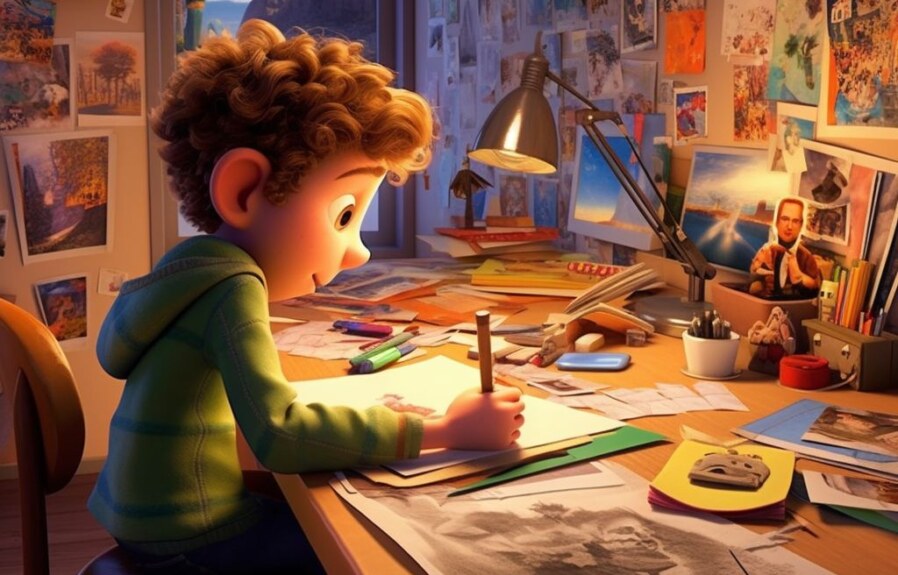Drawing a side profile can be a challenging task for many artists as it requires a great deal of attention to detail and accuracy. However, with the right approach and techniques, anyone can master the art of drawing a side profile. In this article, we will guide you through the process of drawing a side profile step by step. Whether you are a beginner or an experienced artist, our tips and tricks will help you improve your skills and create jaw-dropping portraits with ease. So, let’s dive in and learn how to draw a side profile like a pro!
1. Introduction to Drawing Side Profile: Understanding the Basics
Drawing a side profile of a person is quite challenging, but with practice and understanding the basics, it can be achieved. It involves creating a realistic image of a person’s face with a three-dimensional effect. The following are tips that beginners can follow to master drawing a side profile.
First, learn the basic structure of a human face. The face is made up of several parts, including the eyes, nose, mouth, ears, and hairline. Understanding the angles, shapes, and proportions of these parts is critical in creating a realistic side profile. Take the time to study references of human faces from different angles.
Second, focus on sketching the lines and shapes of the face before adding details. This process involves drawing the outline of the head and the different parts of the face. It would help if you practiced drawing the lines of the jaw and cheekbone, as they are crucial in creating depth and dimension. You can also add shading to create a three-dimensional effect.
In conclusion, drawing a side profile requires a bit of patience and practice. Mastering the basics of the human face, such as angles and proportions, is essential in creating a realistic image. With the proper knowledge and techniques, anyone can learn how to draw a perfect side profile.
2. Getting Started: Essential Tools and Materials for Drawing Side Profile
To draw a side profile, you will need some essential tools and materials. Here are some items that you can use to get started:
– Pencils: Graphite pencils come in different grades and are suitable for creating different shades from light to dark. Use a harder pencil, such as 2H or 4H, for light lines, and a softer pencil, such as 2B or 4B, for dark lines.
– Erasers: A kneaded eraser is a versatile eraser that can be shaped to remove small or large areas of graphite. You can also use a vinyl eraser to erase more stubborn markings.
– Paper: Choose a smooth surface paper that can handle the different pressures of drawing with pencils. You can try using bristol board, drawing paper or sketch paper.
– Reference Material: To draw a side profile, it’s important to have a reference to look at. You can refer to a photograph, a portrait, or even a mirror.
Once you have these materials, set up your workspace in a well-lit area to start drawing. Remember to practice your strokes and don’t be afraid to experiment! Good luck!
3. Steps to Drawing Side Profile: Techniques for Proportion and Placement
To create a successful side profile drawing, one must focus on proportion and placement. Here are some techniques that can be used to achieve the desired results.
– Start by sketching the basic shape of the head: It is important to depict the basic outline of the head while keeping in mind the proper proportions. The forehead and chin should have an equal distance from the vertical line that represents the center of the face.
– Draw the construction lines: Construction lines can help you create the direction of the nose, mouth, and eyebrows. For the nose, draw a line from the center of the forehead to the tip of the nose, and from there to the chin. The mouth line can be drawn by using the midpoint of the distance between the bottom of the nose and the chin. Finally, create the direction of the eyebrows by drawing an imaginary line that passes through the center of the eye.
– Render the details: Once the construction lines are in place, focus on refining the details. Draw the eyes, ears, nose, and mouth, ensuring that they are in proportion with each other. Use shading to give depth and dimension to the drawing.
By following these techniques, you can create a side profile drawing that is accurate and visually appealing. Remember to practice consistently and experiment with different styles to find what works best for you.
4. Adding Depth and Detail: Tips for Shading and Texture in Side Profile Drawing
Shading and Texture Techniques for Side Profile Drawing
One of the main goals when drawing a side profile is to create depth and dimensionality. This can be achieved through careful shading and adding texture. Here are some tips to help you bring your side profile drawings to the next level:
- Use different shading techniques: Different techniques can be used to add depth to your drawing. Examples include hatching, cross-hatching, stippling, and blending. Experiment with different techniques to see which ones work best for you.
- Observe the light source: Before shading, it’s important to observe the light source in your drawing. This will help you determine where the shadows and highlights will fall. Try to create a gradual transition from light to shade.
- Add texture: Texture can help make your drawing more realistic. Create texture by varying the pressure and direction of your strokes. For example, if you are drawing hair, use short, choppy strokes to create a sense of texture and movement.
Remember, shading and texture are all about creating an illusion of depth. By paying close attention to light and texture, you can bring your side profile drawings to life. Practice these techniques to improve your skills and make your drawings stand out.
5. Common Mistakes to Avoid When Drawing Side Profile
- Forcing symmetry: One of the most common mistakes artists make while drawing the side profile is trying to create a perfectly symmetrical face. However, human faces are not entirely symmetrical, and forcing it can make the drawing look unrealistic.
- Ignoring the proportions: Every face has a unique set of proportions, and ignoring them can make the drawing look odd. Pay attention to details such as the distance between the eyes, length of the nose, and width of the mouth.
- Using straight lines: Another mistake artists make is using straight lines to draw the face. However, the natural curves of the face give it depth and character. Use curved lines to create a sense of volume and structure in the face.
- Skipping the details: Paying attention to the details can take your drawing to the next level. Include features like wrinkles, bumps, and folds to create a more realistic image of a person. Skipping these details can make the drawing look incomplete and unprofessional.
- Overdoing the shading: While shading is essential to create depth and make the drawing look more realistic, overdoing it can make the image look unnatural. Make sure to blend the shades carefully and use them sparingly.
Remember, these are just a few mistakes that artists make while drawing the side profile. However, avoiding these mistakes is essential to create a realistic image of a person. Take your time, pay attention to the details, and practice regularly to refine your skills.
6. Practicing and Refining Your Skills: Exercises and Resources for Improving Side Profile Drawing
To improve your side profile drawing skills, practice is key. Here are some exercises and resources to help you refine your abilities:
– Sketchbooks: Keep a sketchbook with you at all times and make an effort to draw profiles whenever you can. This will help you hone your observation skills and enable you to make quick drawings that capture the essence of your subject.
– Drawing Exercises: Try exercises that challenge you to draw profiles from different angles and perspectives. For example, try drawing profiles at eye level, from a high vantage point, and from a low vantage point. This will help you get comfortable with drawing profiles from a variety of perspectives.
– Online Resources: The internet is a treasure trove of resources for aspiring artists. Look for tutorials and videos that focus on drawing profiles. There are countless resources out there, so take the time to find ones that work best for you.
Remember, improving your side profile drawing skills takes time and practice. Be patient with yourself, keep practicing, and seek out resources that can help you refine your abilities. With hard work and dedication, you can become a master of drawing profiles!
7. Conclusion: Tips for Advancing Your Side Profile Drawing Abilities
Improving your side profile drawing abilities may seem challenging, but with consistency and practice, you can achieve impressive results. To hone your skills further, here are some tips to take you to the next level:
- Observe: One of the most essential skills required to become a great artist is observing. Take time to notice the proportions, angles, and curves of different side profile images. With practice, your observational skills will improve, and you can create more accurate drawings.
- Practice: As with any other skill, consistency is key when it comes to improving your side profile drawings. Dedicate at least an hour each day to sketch different side profile images. With practice, you will notice an improvement in your skills.
- Experiment: Don’t limit yourself to one style of drawing. Experiment with different mediums like charcoal, graphite, and ink. Explore different techniques such as stippling and cross-hatching to create unique textures and styles in your work.
- Seek Feedback: Don’t be afraid to seek out feedback from other artists or instructors. Critique can be helpful in identifying areas of weakness, and it can help you identify areas where you can improve.
- Stay motivated: Finally, stay motivated throughout the journey. Celebrate your progress, no matter how small, and use setbacks as opportunities to learn and improve your skills.
Success in art is all about consistency, practice, and a willingness to learn new things. Follow these tips, and you’ll be on your way to advancing your side profile drawing abilities in no time.
People Also Ask:
1. What is a side profile in drawing?
A side profile is a representation of a person’s face or body seen from the side. It allows an artist to capture the unique features of an individual, such as the shape of their nose or the curve of their jawline.
2. How do you draw a realistic side profile?
To draw a realistic side profile, start with a basic outline of the head and then add features such as the eyes, nose, mouth, and ears. Pay close attention to the proportions and angles of the features, and shade in the shadows and highlights to add depth.
3. What are some tips for drawing a side profile?
Some tips for drawing a side profile include using reference images to study the proportions and angles of the face, practicing sketching basic shapes and features to improve your technique, and using shading and highlights to add depth and dimensionality.
4. Why is drawing a side profile important?
Drawing a side profile can be important for artists who want to capture the unique features of a subject’s face, or for those who are working on portraiture. It can also be a good way to practice and improve your drawing skills.
5. Can you draw a side profile using digital tools?
Yes, you can draw a side profile using digital tools such as a graphics tablet and software like Photoshop or Procreate. These tools allow you to easily adjust and modify your drawings, and can be a good option for artists who prefer to work on a digital platform.
Conclusion:
Drawing a side profile is an important skill for any artist, whether you’re working on portraiture, character design, or just practicing your technique. With some basic knowledge of proportions and shading, you can capture the unique features of an individual and create a realistic and striking drawing. Whether you’re using traditional or digital tools, practicing regularly and studying reference images can help you improve your skills and create stunning works of art.



